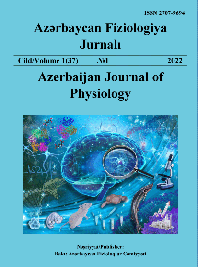Abstract
In the presented article, the effect of hypoxia in prenatal ontogenesis on the activity of the GABA-T enzyme in various structures of the brain of 17-day-old, 1-month-old, and 3-month-old rats in the postnatal period of development was investigated. In experiments, the cortex of the cerebral hemispheres, cerebellum, hypothalamus, medulla oblongata, and midbrain were studied. It was found that in control animals, a high level of activity of the GABA-T enzyme is noted in the hypothalamus and cerebellum compared with other studied structures. It was found that hypoxia suffered by rats in the fetal period causes significant changes in the activity of the GABA-T enzyme, especially expressed in the hypothalamus and cortex of the cerebral hemispheres. In 17-day-old and 1-month-old rats that underwent prenatal hypoxia, in comparison with 3-month-old animals, the enzymatic activity in the studied brain structures decreased to a greater extent. The activity of the GABA-T enzyme was partially restored in the brain structures of three-month-old animals subjected to hypoxia during the fetal period. A decrease in the activity of the GABA-T enzyme leads to an increase in GABA. GABA is involved in compensatory-adaptive reactions. An increase in GABA content promotes the activation of inhibition processes in the brain, protecting nerve cells from death. As a result, GABA protects brain cells from destruction under hypoxic conditions in prenatal ontogenesis.
References
Гадирова Л.Б. Сравнительная характеристика активности глутаминазы в ткани различных структур мозга у потомства крыс, перенесших гипоксию на разных этапах беременности. Azərb. Fiziol. J. 2015;33:155-160. [Gadirova LB. Comparative characteristics of glutaminase activity in the tissues of different brain structures in offspring of rats subjected to hypoxia at different stages of pregnancy. Azerb. J. Physiol. 2015;33:155-60.]
Нилова Н.С. Аммиак и ГАМК-трансаминазная активность ткани головного мозга. Докл. АН СССР, 1966;2:483-486. [Nilova NS. Ammonia and GABA-transaminase activity of brain tissue. Doklady Akademii nauk SSSR, 1966;2:483-486.]
Солкин А.А., Белявский Н.Н., Кузнецов В.И., Николаева А.Г. Основные механизмы формирования защиты головного мозга при адаптации к гипоксии. Вестник ВГМУ. 2012;11(1):6 14. [Solkin AA, Belyavsky NN, Kuznetsov VI, Nikolaeva AG. The main mechanisms of formation of brain protection during adaptation to hypoxia. Vestnik VGMU. 2012;11(1):6-14.]
Трофимова Л.К., Маслова М.В., Граф А.В. и др. Влияния антенатального гипоксического стресса разной этиологии на самцов: корреляция поведенческих паттернов с изменениями активности антиоксидантной защиты и метаболизма ГАМК. Нейрохимия. 2008;25(1-2):86-89. [Trofimova LK, Maslova MV, Graf AV. Effects of antenatal hypoxic stress of various etiologies on males: correlation of behavioral patterns with changes in antioxidant defense activity and GABA metabolism. Neurochemistry (Moscow). 2008;25(1-2):86-89.]
Khairova VR, Agayev TM. α-ketoglutarate dehydrogenase activity in rat brain after hypoxia during embryonic organogenesis of prenatal development. Azerb J Physiol. 2015;33:168-172.
Cao-Lei L, de Rooij SR, King S, Matthews SG, Metz GAS, Roseboom TJ, Szyf M. Prenatal stress and epigenetics. Neurosci Biobehav Rev. 2020 Oct;117:198-210. https://doi.org/10.1016/j.neubiorev.2017.05.016.
Chinopoulos C, Zhang SF, Thomas B, Ten V, Starkov AA. Isolation and functional assessment of mitochondria from small amounts of mouse brain tissue. Methods Mol Biol. 2011;793:311-24. https://doi.org/10.1007/978-1-61779-328-8_20.
Cunha-Rodrigues MC, Balduci CTDN, Tenório F, Barradas PC. GABA function may be related to the impairment of learning and memory caused by systemic prenatal hypoxia-ischemia. Neurobiol Learn Mem. 2018 Mar;149:20-27. https://doi.org/10.1016/j.nlm.2018.01.004.
Fine R, Zhang J, Stevens HE. Prenatal stress and inhibitory neuron systems: implications for neuropsychiatric disorders. Mol Psychiatry. 2014 Jun;19(6):641-651. https://doi.org/10.1038/mp.2014.35.
Lenin D. Ochoa-de la Paz, Rosario Gulias-Cañizo, Estela D´Abril Ruíz-Leyja et al. The role of GABA neurotransmitter in the human central nervous system, physiology, and pathophysiology. Rev Mex Neuroci., 2021;22(2):67-76. https://doi.org/10.24875/rmn.20000050
Nalivaeva NN, Turner AJ, Zhuravin IA. Role of Prenatal Hypoxia in Brain Development, Cognitive Functions, and Neurodegeneration. Front Neurosci. 2018 Nov 19;12:825. https://doi.org/10.3389/fnins.2018.00825.
Nisimov H, Orenbuch A, Pleasure SJ, Golan HM. Impaired Organization of GABAergic Neurons Following Prenatal Hypoxia. Neuroscience. 2018 Aug 1;384:300-313. https://doi.org/10.1016/j.neuroscience.2018.05.021.
Piešová M, Mach M. Impact of perinatal hypoxia on the developing brain. Physiol Res. 2020 Apr 30;69(2):199-213. https://doi.org/10.33549/physiolres.934198.
Pozdnyakova N, Dudarenko M, Yatsenko L, Himmelreich N, Krupko O, Borisova T. Perinatal hypoxia: different effects of the inhibitors of GABA transporters GAT1 and GAT3 on the initial velocity of [3H]GABA uptake by cortical, hippocampal, and thalamic nerve terminals. Croat Med J. 2014 Jun 1;55(3):250-8. https://doi.org/10.3325/cmj.2014.55.250.
Wu Q, Su N, Huang X, Cui J, Shabala L, Zhou M, Yu M, Shabala S. Hypoxia-induced increase in GABA content is essential for restoration of membrane potential and preventing ROS-induced disturbance to ion homeostasis. Plant Commun. 2021 May 1;2(3):100188. https://doi.org/10.1016/j.xplc.2021.100188.
Silvestro S, Calcaterra V, Pelizzo G, Bramanti P, Mazzon E. Prenatal Hypoxia and Placental Oxidative Stress: Insights from Animal Models to Clinical Evidences. Antioxidants (Basel). 2020 May 12;9(5):414. https://doi.org/10.3390/antiox9050414

This work is licensed under a Creative Commons Attribution 4.0 International License.
Copyright (c) 2022 Azerbaijan Journal of Physiology




